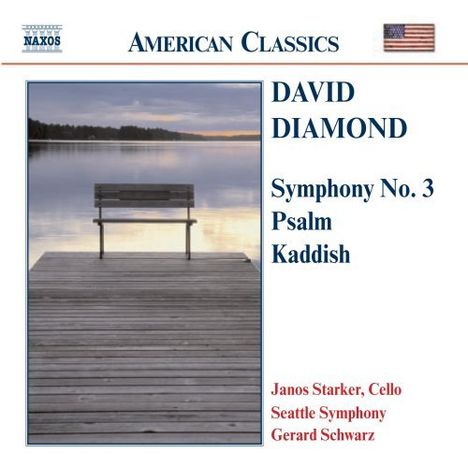David Diamond: Symphonie Nr.3 auf CD
Symphonie Nr.3
Herkömmliche CD, die mit allen CD-Playern und Computerlaufwerken, aber auch mit den meisten SACD- oder Multiplayern abspielbar ist.
+Kaddish für Cello & Orchester; Psalm (1936)
- Künstler:
- Starker, Seattle SO, Schwarz
- Label:
- Naxos
- Aufnahmejahr ca.:
- 1990/1991
- Artikelnummer:
- 3518926
- UPC/EAN:
- 0636943915523
- Erscheinungstermin:
- 7.6.2004
- Serie:
- Naxos American Classics
Diamond komponierte seine Sinfonie Nr. 3 1945, musste aber weitere fünf Jahre auf ihre Uraufführung mit Charles Munch und der Boston Symphony warten. Ursprünglich, so der Komponist, hatten Artur Rodzinski und die Chicago Symphony versprochen, sie aufzuführen, "aber es kam immer wieder etwas dazwischen, und sie wurde nie gespielt". Einige Jahre später begegnete Diamond, der Munch seit 1936 kannte, in Paris dem Dirigenten des Bostoner Symphonieorchesters, zeigte ihm die Partitur und erklärte ihm die Schwierigkeiten, auf die er beim Versuch, sie aufzuführen, gestoßen war. "Aber das ist lächerlich - wir müssen sie zur Aufführung bringen. Ich werde es in der nächsten Saison tun." Munch hielt sein Versprechen.
1987 schlug Gerard Schwarz Diamond vor, ein Werk für Yo-Yo Ma zu komponieren. "Wissen Sie", sagte der Komponist, "ich wollte schon immer ein Kaddish [das alte hebräische Totengebet] schreiben; tatsächlich habe ich jahrelang versucht, eines für Cello und Klavier zu schreiben, aber das Klavier schien mir zu schwach für die Konzeption, die ich im Kopf hatte. Vielleicht kann ich jetzt ein Kaddisch für Cello und Orchester schreiben..."
Diamond bezeichnet Kaddish als ein "rituelles" Stück. Obwohl mit dem eigentlichen hebräischen Gebet traditionelle Melodien verbunden sind, schuf der Komponist auf der Grundlage seiner Kenntnisse der cantorialen Gesangspraktiken seine eigenen. Dies sagte Diamond über die Komposition, die er 1989 vollendete.
1936 besuchte Diamond den Pariser Friedhof Père Lachaise, um an den Gräbern von Oscar Wilde und Sarah Bernhardt, neben anderen dort beigesetzten Künstlerpersönlichkeiten, seine letzte Ehre zu erweisen. Die "Begegnung" inspirierte ihn zur Komposition eines Psalms, den er André Gide widmete, den er im selben Jahr, nachdem er die Komposition bereits vollendet hatte, kennen lernte. Tatsächlich spielten Diamond and Gide eine vierhändige Bearbeitung des Psalms vor seiner orchestralen Uraufführung in Rochester beim Festival of American Music 1937 unter der Leitung von Howard Hanson durch.
Product Information
Diamond composed his Symphony No. 3 in 1945, though it had to wait another five years for its première with Charles Munch and the Boston Symphony. Initially, according to the composer, Artur Rodzinski and the Chicago Symphony had promised to perform it, "but things kept coming up, and it was never played." Several years later, Diamond, who had known Munch since 1936, ran into the Boston Symphony Orchestra’s conductor in Paris, showed him the score and explained the difficulties he had faced in trying to get it performed. "But this is ridiculous–we must have it performed. I will do it next season." Munch lived up to his promise.
In 1987 Gerard Schwarz suggested to Diamond that he compose a work for Yo-Yo Ma. "You know," said the composer, "I’ve always wanted to write a Kaddish [the ancient Hebrew prayer for the dead]; in fact, I tried for years to write one for cello and piano, but the piano seemed too weak for the conception I had in mind. Maybe now I can write a Kaddish for cello and orchestra…"
Diamond refers to Kaddish as a "ritual" piece. Though the actual Hebrew prayer has traditional melodies associated with it, the composer created his own, based on his knowledge of cantorial singing practices. Diamond had this to say about the composition, which he completed in 1989.
In 1936, Diamond visited the Père Lachaise Cemetery in Paris to pay his respects at the graves of Oscar Wilde and Sarah Bernhardt, among other artistic notables interred there. The "encounter" inspired him to compose Psalm, which he dedicated to André Gide, whom he met that same year after he had already completed the composition. Diamond and Gide, in fact, played through a four-hand arrangement of Psalm before its orchestral première in Rochester at the 1937 Festival of American Music conducted by Howard Hanson.
Disk 1 von 1 (CD)
-
1 Psalm
-
2 Kaddish for Cello and Orchestra
-
3 Symphony No. 3: Allegro deciso
-
4 Symphony No. 3: Andante
-
5 Symphony No. 3: Allegro vivo
-
6 Symphony No. 3: Adagio assai
Mehr von David Diamond






